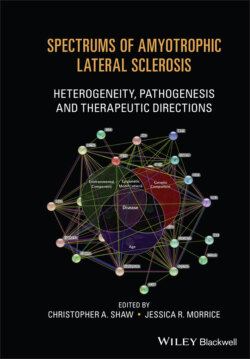Читать книгу Spectrums of Amyotrophic Lateral Sclerosis - Группа авторов - Страница 19
PLEIOTROPY OF ALS GENES
ОглавлениеSOD1 is the only ALS‐associated gene that has been associated exclusively with an isolated motor phenotype. A common phenomenon for all other ALS genes is pleiotropy, which means a genetic variant can be associated with multiple phenotypic traits. The same genetic variant can cause not only different ALS subtypes in families, in terms of age of onset and disease course, but also different diseases. Examples of pleiotropic genes are C9orf72 and VCP. In the same family, C9orf72 carriers can have only ALS, only FTD, or overlapping ALS/FTD phenotypes. Furthermore, the same pathogenic variant in VCP has been detected in patients with ALS, FTD, IBM, and Charcot‐Marie‐Tooth type 2 (CMT2) [67]. The opposite is also true: different pathogenic variants in the same ALS‐associated gene can cause an identical phenotype.
TABLE 1.1 Spectrum of clinical disease phenotypes associated with genetic variants.
| ALS | FTD | Myopathy | Parkinson's disease | Paget's disease | Others | |
|---|---|---|---|---|---|---|
| SOD1 | +44 | – | – | – | – | – |
| C9orf72 | +24,25 | +24,25 | – | +45 | +/−46 | Psychiatric disorders [33], Huntington disease [34] |
| TARDBP | +47,48 | +49 | – | +50 | – | – |
| FUS | +51,52 | +53 | – | – | – | Hereditary essential tremor 4 [35] |
| NEK1 | +54 | – | – | – | – | Short‐rib thoracic dysplasia [36] |
| TBK1 | +55 | +56 | – | – | – | Herpes simplex encephalitis [37] |
| MATR3 | +32 | +32 | +57 | – | – | – |
| VCP | +29 | +58 | +58 | – | +58 | Charcot‐Marie‐Tooth type 2 [38] |
| SQSTM1 | +30 | +59 | +60 | – | +61 | Childhood‐onset neurodegeneration with ataxia, dystonia, and gaze palsy [39] |
| OPTN | +62 | +63 | – | +64 | +65 | Open angle glaucoma [40] |
| KIF5A | +66 | – | – | – | – | Hereditary spastic paraplegia [41], Charcot‐Marie‐Tooth type 2 [42], neonatal intractable myoclonus [43] |
Presence (+) or absence (−) of clinical signs in patients with variants in different genes is reported in the table.
High‐throughput sequencing studies have shown that a consistent number of patients with the C9orf72 expansion have additional variants in other ALS‐associated genes, suggesting that pleiotropy can be explained by an oligogenic model [5, 27,68–70].
With rare exceptions, it is not possible to establish a genotype–phenotype correlation in ALS. The variants p.D11Y, p.D90A, and p.G93D in SOD1 are associated with a relatively benign form of motor neuron disease with distal limb distribution [71–74], while p.A4V and p.G85S are associated with a rapid course [75, 76]. Some mutations in FUS, including p.P525L and frameshift mutations, are frequently associated with juvenile‐onset ALS with an aggressive course [77–79].
